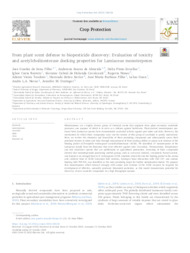From plant scent defense to biopesticide discovery: evaluation of toxicity and acetylcholinesterase docking properties for Lamiaceae monoterpenes.
From plant scent defense to biopesticide discovery: evaluation of toxicity and acetylcholinesterase docking properties for Lamiaceae monoterpenes.
Autoria: SENA FILHO, J. G. de; ALMEIDA, A. S. de; PINTO ZEVALLOS, D.; BARRETO, I. C.; CAVALCANTI, S. C. de H.; NUNES, R.; TEODORO, A. V.; XAVIER, H. S.; BARBOSA FILHO, J. M.; GUAN, L.; NEVES, A. L. A.; DURINGER, J. M.
Resumo: Monoterpenes are a highly diverse group of chemical scents that originate from plant secondary metabolic processes, one purpose of which is to serve as a defense against herbivores. Plant-derived monoterpenes pro- duced from Lamiaceae species have demonstrated acaricidal activity against pest mites and ticks. However, the mechanism by which these compounds carry out the demise of this group of arachnids is poorly understood. Here, we review the chemistry and bioactivity of these promising compounds and subsequently assess their potential toxicity to mites and ticks through measurement of their docking ability to amino acid residues of the binding pocket of Drosophila melanogaster acetylcholinesterase (AChE). We identified 27 monoterpenes of the Lamiaceae family from the literature that were effective against mite (Varroidae, Tetranychidae, Eriophyidae) and tick (Ixodidae) species that are problematic in agricultural production. Screening of these compounds showed that monoterpenoids possessing methyl groups, such as carvacrol, linalool, ?-terpineol, bornyl acetate, and terpine-4-ol, strongly bind to D. melanogaster AChE. Linalool, which fits into the binding pocket in the amino acid catalytic triad of AChE (oxyanion hole residues, hydrogen bond interaction with GLU 237, and anionic binding with TRP 83), was identified as the most promising target for further optimization studies. We propose that monoterpenes which interact strongly with amino acid residues of the AChE receptor be targeted for development of effective, naturally produced biocontrol pesticides, as this model demonstrates potential for discovery of new acaricide compounds in a high throughput manner
Ano de publicação: 2023
Tipo de publicação: Artigo de periódico
Unidade: Embrapa Tabuleiros Costeiros
Palavras-chave: Aroma, Biopesticida, Essential oils, Pesticida, Ácaros, Óleo Essencial
Observações
1 - Por padrão são exibidas publicações dos últimos 20 anos. Para encontrar publicações mais antigas, configure o filtro ano de publicação, colocando o ano a partir do qual você deseja encontrar publicações. O filtro está na coluna da esquerda na busca acima.
2 - Para ler algumas publicações da Embrapa (apenas as que estão em formato ePub), é necessário ter, no celular ou computador, um desses softwares gratuitos. Sistemas Android: Google Play Livros; IOS: iBooks; Windows e Linux: software Calibre.
Acesse outras publicações
Acesse a Base de Dados da Pesquisa Agropecuária (BDPA) para consultar o acervo completo das bibliotecas da Embrapa.

